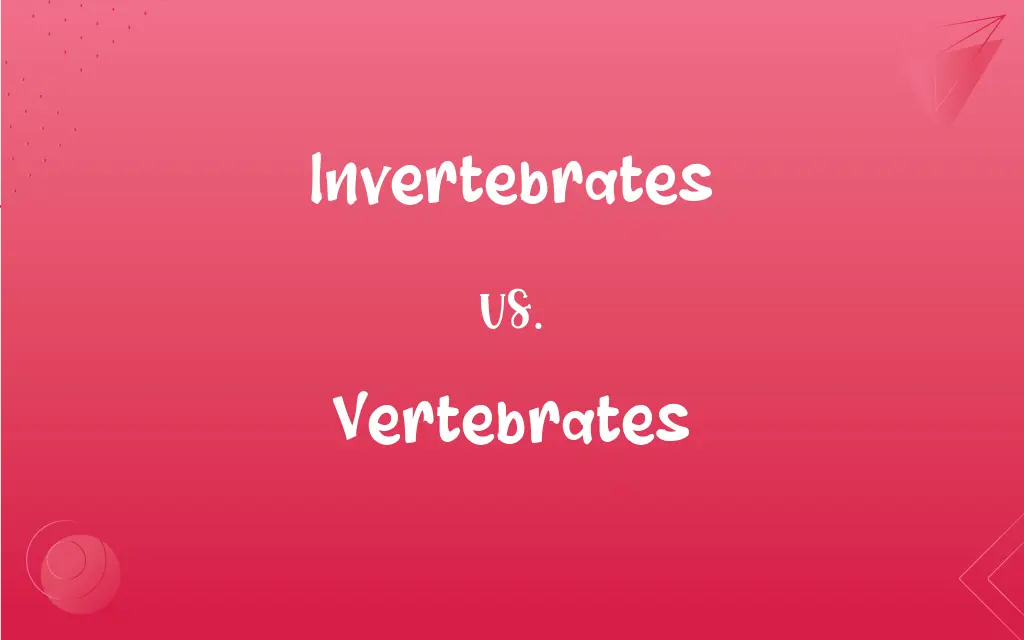Invertebrates vs. Vertebrates: What's the Difference?
Edited by Janet White || By Harlon Moss || Updated on October 28, 2023
Invertebrates lack a vertebral column (spine), while vertebrates possess a spine and an internal skeleton made of bone or cartilage. Both represent distinct classifications within the animal kingdom based on skeletal structure.

Key Differences
Invertebrates and vertebrates are two primary classifications in the animal kingdom, differentiated primarily by their skeletal systems. Invertebrates are animals that don't possess a vertebral column, or spine. This group includes a vast array of species, from simple organisms like sponges and jellyfish to more complex ones like octopuses and insects. Their structural support typically comes from other means, such as exoskeletons in insects or the fluid-filled cavities in cnidarians.
Vertebrates, in contrast, are characterized by having a vertebral column, which is a series of bones or cartilage that surrounds and protects the spinal cord. This group encompasses animals like mammals, birds, reptiles, amphibians, and fish. The presence of the vertebral column provides these animals with more advanced structural support and flexibility, enabling a broad range of movements and adaptations.
It's crucial to note that while vertebrates are more complex in terms of skeletal and many physiological systems, invertebrates account for a much larger percentage of animal species on Earth. In fact, over 95% of known animal species are invertebrates, showcasing their immense diversity and adaptability.
Despite these differences, both invertebrates and vertebrates play vital roles in maintaining ecological balance. From pollination by insects (invertebrates) to seed dispersal by birds (vertebrates), their interactions shape ecosystems. Understanding the differences between these two classifications can provide insights into their unique evolutionary paths and ecological roles.
Comparison Chart
Skeletal Structure
Lack vertebral column
Possess a vertebral column
ADVERTISEMENT
Examples
Insects, mollusks, arachnids
Mammals, birds, fish, reptiles, amphibians
Percentage of Animal Species
Over 95%
Less than 5%
Body Support
Exoskeletons, fluid-filled cavities
Internal skeleton of bone/cartilage
Nervous System Complexity
Generally simpler
More complex, with a pronounced brain
Invertebrates and Vertebrates Definitions
Invertebrates
Animals lacking a vertebral column.
Butterflies are invertebrates known for their colorful wings.
ADVERTISEMENT
Vertebrates
Animals that possess a vertebral column.
Dolphins are vertebrates known for their intelligence and playful nature.
Invertebrates
Species lacking an internal skeleton made of bone.
Jellyfish are invertebrates that drift in the ocean currents.
Vertebrates
Creatures belonging to the vertebrate subphylum.
Frogs are vertebrates that undergo metamorphosis from tadpoles.
Invertebrates
Members of the animal kingdom without a spine.
Snails, as invertebrates, carry a protective shell instead of having a backbone.
Vertebrates
Species with an internal skeleton made of bone or cartilage.
Sharks, as vertebrates, have a skeleton made of cartilage.
Invertebrates
Organisms without a backbone.
The common earthworm is an invertebrate found in many gardens.
Vertebrates
Members of the animal kingdom with a spine.
As vertebrates, kangaroos have a strong tail and backbone to support their hopping motion.
Invertebrates
Creatures that don't belong to the vertebrate subphylum.
Starfish are marine invertebrates with unique regenerative abilities.
Vertebrates
Organisms equipped with a backbone.
Eagles, as vertebrates, have strong bones that aid their flight.
Invertebrates
Lacking a backbone or spinal column; not vertebrate.
Vertebrates
Having a backbone or spinal column.
Invertebrates
Of or relating to invertebrates
Invertebrate zoology.
Vertebrates
Of or characteristic of vertebrates or a vertebrate.
Invertebrates
An animal, such as an insect or mollusk, that lacks a backbone or spinal column.
Vertebrates
Any of numerous chordate animals of the subphylum Vertebrata, characterized by a segmented spinal column and a distinct well-differentiated head. The vertebrates include the fishes, amphibians, reptiles, birds, and mammals.
Invertebrates
Plural of invertebrate
Vertebrates
Plural of vertebrate
FAQs
Which group has a larger species count?
Invertebrates, representing over 95% of known animal species.
Are all fish vertebrates?
Yes, fish have a vertebral column and are classified as vertebrates.
What distinguishes invertebrates from vertebrates?
Invertebrates lack a vertebral column, while vertebrates possess one.
What's a common invertebrate found in homes?
Spiders are invertebrates often found in homes.
Can invertebrates be larger than vertebrates?
While many invertebrates are small, some like certain squids can be quite large, though generally vertebrates include the largest animals.
Which group includes amphibians?
Amphibians are vertebrates.
Do invertebrates have a brain?
Some invertebrates have simple brain structures, while others have more distributed nerve networks.
Are there vertebrates that live exclusively in water?
Yes, fish are vertebrates that live solely in water.
Which invertebrates are commonly known for their stinging cells?
Cnidarians, like jellyfish and sea anemones, have stinging cells known as nematocysts.
Do all vertebrates give birth to live young?
No, while some vertebrates like many mammals give birth to live young, others, such as birds and reptiles, lay eggs.
Can invertebrates possess hard external structures?
Yes, many invertebrates, like crustaceans and certain mollusks, have hard external shells or exoskeletons.
Which group primarily uses exoskeletons for support?
Invertebrates, especially insects, utilize exoskeletons.
Are mammals always vertebrates?
Yes, all mammals are vertebrates with a backbone.
What's a primary advantage of having an exoskeleton, like some invertebrates?
Exoskeletons offer protection and support without an internal skeleton.
In terms of evolution, which came first: invertebrates or vertebrates?
Invertebrates are older in evolutionary terms, with the earliest vertebrates appearing later.
Do vertebrates always have bones?
Not always; some, like sharks, have skeletons made of cartilage.
Is the presence of a vertebral column the only defining feature of vertebrates?
While the vertebral column is a primary characteristic, vertebrates also share other anatomical and physiological features.
Why are invertebrates so diverse in species compared to vertebrates?
Invertebrates have been around for a longer evolutionary time, have varied habitats, and many reproduce rapidly, leading to high diversity.
Are birds considered vertebrates?
Yes, birds have a vertebral column and are classified as vertebrates.
Do all vertebrates have a similar vertebral column structure?
No, the structure and number of vertebrae can vary widely among different vertebrate species.
About Author
Written by
Harlon MossHarlon is a seasoned quality moderator and accomplished content writer for Difference Wiki. An alumnus of the prestigious University of California, he earned his degree in Computer Science. Leveraging his academic background, Harlon brings a meticulous and informed perspective to his work, ensuring content accuracy and excellence.
Edited by
Janet WhiteJanet White has been an esteemed writer and blogger for Difference Wiki. Holding a Master's degree in Science and Medical Journalism from the prestigious Boston University, she has consistently demonstrated her expertise and passion for her field. When she's not immersed in her work, Janet relishes her time exercising, delving into a good book, and cherishing moments with friends and family.































































